Explore India’s rich heritage, showcasing its sacred sites and majestic landscapes that capture the soul of its ancient civilization.

Rich in history and spirituality, with a mix of cultures and religions, India casts its spell on seekers of living heritage and sacred sites. Ancient monuments and sacred sites whisper stories from old civilizations, gods and goddesses, and incredible architecture.
“Echoes of Eternity” invites you on a journey to explore some of India’s most majestic heritage and sacred sites, where every stone tells a story and every location breathes life into myths and legends.
As we journey through the sacred sites it becomes evident that the heritage sites of India are not merely relics of the past but are vibrant examples of living heritage, deeply ingrained in the life and spirituality of the people. Each of these sacred destinations pulsates with the rhythm of devotion, tradition, and cultural practices that have transcended centuries.
Varanasi: The Spiritual Heart of India
Varanasi, one of the world’s oldest inhabited cities, is a melting pot of life, death, and rebirth. Situated on the banks of the Ganges River, it is a place where the physical and spiritual worlds intertwine. The Ghats of Varanasi, with their continuous rhythm of life and death, present a unique spectacle to visitors.

The Kashi Vishwanath Temple, dedicated to Lord Shiva, stands as a testament to the city’s ancient religious importance. Pilgrims from across the globe come here to wash away their sins in the sacred waters or to cremate their loved ones, hoping for moksha—liberation from the cycle of rebirth.
Living Heritage
In Varanasi, the spiritual heartbeat of India, the ghats and temples are staged for daily rituals and ceremonies that trace back millennia, illustrating a continuity of faith and tradition that flows as perennially as the Ganges. Here, life and death dance in an eternal cycle, witnessed by pilgrims and saints who seek solace and salvation in its sacred waters.
The Architectural Marvel of Hampi
In the southern state of Karnataka lies Hampi, the erstwhile capital of the Vijayanagara Empire, now a UNESCO World Heritage site. The ruins of Hampi, set against a rugged backdrop of boulder-strewn hills, tell the tale of a prosperous city that was once the epicentre of trade and religion.

The Virupaksha Temple, dating back to the 7th century, is still an active place of worship and a key attraction. The intricate stone carvings and magnificent architecture of the Vijaya Vittala Temple showcase the advanced craftsmanship of the era. Hampi’s landscape, dotted with over 1,600 remains, including temples, palaces, and market streets, offers a surreal experience to its visitors.
Living Heritage
Hampi, with its ruins whispering tales of grandeur and fall, is still a revered site, hosting vibrant festivals that celebrate the legacy of the Vijayanagara Empire. The locals’ reverence for these ruins and the stories they encapsulate breathes life into the stones, making history tangible.
The Sacred City of Amritsar
Amritsar, home to the Golden Temple, is a city that embodies the spirit and resilience of Sikhism. The Golden Temple, or Harmandir Sahib, is a symbol of brotherhood and equality. Surrounded by a serene lake, the temple’s golden facade reflects beautifully, especially at night.
It is not just a place of worship but a community kitchen, or Langar, that feeds thousands of people daily, regardless of caste, creed, or religion.
The Jallianwala Bagh, a short walk from the temple, is a sombre reminder of India’s struggle for independence, making Amritsar a city of both spiritual solace and patriotic pride.
Living Heritage
Amritsar’s Golden Temple serves as a luminous beacon of Sikh faith and community, embodying the principles of service and equality. It’s not just a monument but a living, breathing centre of spirituality and hospitality, where the Langar feeds thousands daily, continuing a centuries-old tradition of communal harmony.
The Timeless Appeal of Khajuraho
The Khajuraho Group of Monuments in Madhya Pradesh is famous for its nagara-style architectural symbolism and its erotic sculptures. A UNESCO World Heritage site, Khajuraho was built between the 10th and 12th centuries by the Chandela dynasty and originally consisted of 85 temples, of which only about 20 have survived the ravages of time.
The temples are renowned for their intricate sculptures and carvings that celebrate human form and emotion in their most candid forms. The temples are divided into three complexes – Western, Eastern, and Southern, with the Western complex being the most famous. The Kandariya Mahadeva Temple, dedicated to Lord Shiva, is the largest and most ornate temple in Khajuraho.
Living Heritage
The erotic sculptures and temples of Khajuraho are a testament to the ancient Indian ethos of celebrating life in all its facets. They remain sites of worship and cultural festivals, demonstrating how the sacred and the sensual coexist, offering insights into a philosophy that sees divinity in all aspects of existence.
The Mystical Call of Bodh Gaya
Bodh Gaya, a small town in Bihar, is one of the most sacred Buddhist sites in the world. It is here, under the Bodhi Tree, that Prince Siddhartha attained enlightenment and became Buddha.
The Mahabodhi Temple, a UNESCO World Heritage site, marks this hallowed spot and is a place of pilgrimage for Buddhists from around the world.
The temple’s architecture is a splendid example of Indian brickwork and has been highly influential in the development of later architectural traditions. Surrounding the temple are numerous other monasteries and temples, built by various Buddhist countries, each adding to the serene and contemplative atmosphere of Bodh Gaya.

Living Heritage
Bodh Gaya stands as a serene witness to the enlightenment of Siddhartha Gautama. It is a global pilgrimage site, where monks, nuns, and laypeople gather to meditate and study. The Bodhi Tree, under which enlightenment was attained, is a living link to this pivotal moment in history, making Bodh Gaya a living bridge between the past and the present, the human and the divine.
Rajasthan’s Mehrangarh Fort: A Citadel of Culture and History
Perched on a rocky cliff 400 feet above the city of Jodhpur, Mehrangarh Fort stands as a testament to the architectural brilliance and the rich history of Rajasthan. This formidable fortress, built in 1459 by Rao Jodha, dominates the city’s skyline and offers breathtaking views of the blue houses below.
Within its thick, impregnable walls lie palaces adorned with intricate carvings, expansive courtyards, and a remarkable collection of royal artefacts housed in the fort’s museum. Mehrangarh Fort is a heritage fort and a cultural hub that hosts festivals, concerts, and art exhibitions, bringing the vibrant traditions of Rajasthan to life.
Living Heritage
Mehrangarh Fort in Rajasthan is not merely an architectural marvel; it’s a living testament to the Rajput era’s glory, culture, and valour.
Mehrangarh Fort continues to be a centre of cultural vitality in Jodhpur, hosting an array of festivals, such as the Rajasthan International Folk Festival, which celebrates the rich musical traditions of the region.
Its museum, one of the most well-stocked in Rajasthan, brings to life centuries-old stories through an extensive collection of palanquins, costumes, paintings, and armoury.
The fort’s continued relevance in the cultural and social life of Jodhpur, along with its enduring beauty and historical significance, exemplifies living heritage, where the past seamlessly blends with the present, making it a sacred site for not only its architectural grandeur but also its cultural vibrancy.
Kerala’s Backwaters: A Serene Journey Through Time
Kerala’s backwaters, a network of interconnected canals, rivers, lakes, and inlets, offer a serene and sublime experience that is quintessentially Indian yet uniquely Keralite. This intricate waterway system, set against the backdrop of lush palm-fringed landscapes, has been the lifeline of the local communities for centuries.
A journey through the backwaters on a traditional houseboat, known as a “Kettuvallam,” unveils the everyday life of the people living along the banks, showcasing a blend of culture, cuisine, and history that has evolved around these waters. The backwaters are a living heritage, where the rhythm of life moves to the gentle flow of water, offering a tranquil escape into nature’s lap.
Living Heritage
The backwaters of Kerala represent a unique living heritage, encapsulating the essence of life in southern India. This network of waterways is integral to the local communities’ daily routines, serving as avenues for transport, fishing, and agriculture. The traditional houseboats that glide along these waters are a testament to age-old shipbuilding skills passed down through generations.
Moreover, the backwaters are central to the state’s ecological system, supporting a diverse range of flora and fauna. The harmonious coexistence of humans with nature observed here is a sacred legacy, highlighting a way of life that respects and relies on the natural world. As visitors journey through these tranquil waters, they witness a lifestyle that has sustained and thrived in these parts for centuries, making Kerala’s backwaters a sacred site of living heritage in the truest sense.
A glimpse into the soul of India
India’s heritage sites are a testament to the country’s architectural brilliance and spiritual depth. They are also a mirror reflecting the diverse tapestry of beliefs, traditions, and cultures that have thrived in this land for centuries. Exploring these sites offers a glimpse into the soul of India—a journey through time that brings to life the echoes of eternity.
From the ghats of Varanasi, the ruins of Hampi, the golden allure of Amritsar, and the erotic sculptures of Khajuraho, to the serene enlightenment of Bodh Gaya, each destination leaves an indelible mark on the traveller, inviting them to delve deeper into India’s mystical past and vibrant present.
These destinations exemplify how India’s heritage sites are not just historical landmarks but are integral to the living fabric of the country’s diverse cultural and spiritual identity, making them truly sacred.
Read more: Latest



